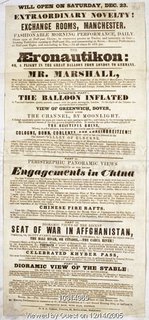
Although I have vowed earlier to cease reading like a shark at a barbecue I could not stop myself when I came across Literature and Visual Media (David Seed, Editor). The first essay Optical Recreations and Victorian Literature by John Plunkett was a fascinating journey through a world of visuality, literature and the popular imagination of 19th century Britain.
Having long been interested in the sources of trope and meme in digital representations Plunkett's essay provided excellent background for early constructions around both the visual and the virtual. On the tromp l'oeil effect of the early panorama shows which were both traveling and stationary in specially built buildings (one from 1793 was 10 000 square feet of canvas!) William Wordsworth was already cautioning against "the opportunity for the spectator to become immersed in its virtual world" in the 1790's in The Prelude (Book Seven). However the caution of the lake bard did little to stem the tide from a cascade of visual entertainments. The relationship with gaming was also early in regards to the virtual:
"The success of large scale panoramas led to hand-held versions, children's games, and miniature toy theater panoramas that could be performed in the parlour. In the early years of the panorama's novelty small hand-held panoramas were published as luxury tourist guides-cum-commemoratives. Among the many produced were panoramas of Falmouth (1806), Brighton (1831), Sidmouth (1821), Weymouth (1820), and the Isle of Wight (1820). Scrolling panoramas were used also to portray public events such as the coronations of George IV in 1818 and Queen Victoria in 1838.. Numerous games based on the aesthetic form and instructional value of the panorama were also produced: examples include the Myriorama (1824), Panoramacopia (1824) and Nautorama (1832). The convergence between print and optical media was thus only part of the latter's capacious influence." (Plunkett:13)
Continuing the trace of material metaphor between such present day technologies such as GIS, augmented reality and the image, the Aeronautikon (1841) provided " images of Mr Marshall's flight from London to Germany in the Aeronautikon balloon, including: the balloon being inflated; leaving Vauxhall Gardens and ascending over London; flying across the channel by moonlight; and flying over the Rhine at sunrise. It also introduces panoramic views of China, Afghanistan and the Khyber Pass"

It is clear from Plunkett's essay that the visual field was developing fast, coming out of Enlightenment concerns and thought. He goes on to cite examples of its influence on such authors as George Eliot, Charles Dickens, Amelia Opie and the works published by Dean and Son.
No comments:
Post a Comment